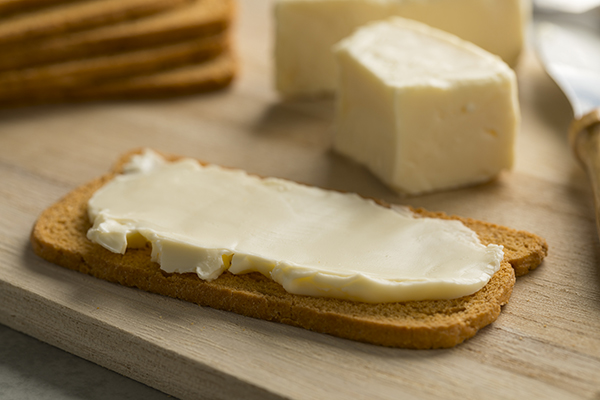Fresh, spreadable, rindless cheese is as simple as cheese gets, and in warm weather, it has extra appeal. Slather it on toast, top with vine-ripe tomatoes or roasted peppers to have a delicious lunch in seconds. Every cheese counter needs a plain fresh chèvre but why stop there? Entice your customers with these new or lesser-known options in fresh cheese and make your counter a must-shop for their summer meals.
Bellwether Farms Sheep Cheese (California): This creamery’s new fresh sheep log is brittle when cold but spreadable at room temperature. Warm it in an oiled ramekin to render it even more luscious. A long, slow fermentation—almost 24 hours—builds lemony flavor and acidity and produces a silken curd with minimal rennet. Scooped into bags to drain for a day with gentle pressure, the curds are then salted and packaged in 3-ounce vacuum-sealed logs. The pull-apart packaging—a terrific development—releases the cheese cleanly. Advise consumers to store any leftover cheese in a lidded container.
Garden Variety Sweet Alyssum (California): Rebecca King makes her delicate, spreadable tub-packed sheep cheese from the milk of her own 100 ewes, pasture-raised in Monterey County. Her flock is primarily Lacaune-East Friesian crosses, and when the milkfat peaks at the end of the summer, it can reach 9 percent—almost three times the milkfat in cow’s milk.
Good Culture Cottage Cheese (Wisconsin and Minnesota): The two young founders of this Southern California company spotted an opportunity in the cottage cheese niche for an organic entry containing live active cultures and no stabilizers. The cheese is made at a Midwest facility using milk from local farms and packed in tubs designed to appeal to a younger, hipper audience than cottage cheese usually draws. The flavor is exceptional: buttery, rich, and mellow with a buttermilk aroma. The small curds are moist and tender, suspended in a tangy cream dressing. Not surprisingly, the full-fat product is creamier than the low-fat version, with only a few more calories. As a supporter of 1% for the Planet, Good Culture donates one percent of its sales to environ
Green Dirt Farm Fresh Sheep Cheese (Missouri): This tub-packed treasure is light and lemony with a clean, cultured flavor. The younger it is, the fluffier it will be, but even a month-old tub will be more tender and less dense than most fresh chèvres. Given how few domestic sheep dairies we have, this item is a leader in a small niche.
Madame Loïk (France): Why is this whipped cheese not more widely available? It’s made by Paysan Breton, a large dairy co-op in Brittany, so production is not particularly limited. It has no objectionable ingredients—just buttermilk, cream, skim milk, cultures, and French sea salt.
Compared to similar cheeses, it’s relatively low fat, yet it tastes like it has a million calories. It has a mellow crème fraîche flavor and a plush texture that beckons rye toast and smoked salmon.
Nettle Meadow Fresh Sheep Cheese (New York): Several East Coast chefs use this lemony cheese in stuffed pasta and on pizza, but the creamery has only recently introduced a 5-ounce retail pack. It is a bit denser and drier than the Bellwether or Green Dirt cheeses, but otherwise similar.
Nicasio Valley Foggy Morning (California): This rindless six-ounce cow’s milk cheese is less than a week old when shipped. Like cream cheese but more delicate, it has an inviting sour-cream aroma and gentle tang. Made with organic milk from Nicasio Valley’s herd and animal rennet, this farmstead cheese can be dolloped on pizza before baking or softened in a ramekin with olive oil and served with crostini and olives.
Pennyroyal Farm Laychee (California): A farmstead cheese from a small producer in the Anderson Valley wine country, Laychee is a mixed-milk cheese: mostly goat but with sheep’s milk added in the months when the sheep are lactating (roughly March through September). Cheesemaker Erika McKenzie-Chapter ferments the milk slowly to develop flavor, then hangs the curd in cheesecloth bags to drain for a day before it’s salted and packed in tubs. A smidgen of rennet makes the curd smoother but it’s mostly the high acidity that makes the curd set. At its freshest, Laychee is airy and fluffy, with none of that tongue-coating clinginess that fresh goat cheese sometimes has. The aroma suggests cottage cheese and lemon peel.
Shepherd’s Way Farms Shepherd’s Hope (Minnesota): A moist, rindless farmstead sheep cheese packaged when only a few days old, Shepherd’s Hope resembles feta without the brine. It is as tender as soft tofu and a welcome change-up in a salad. Enjoy it in Greek salad or with roasted peppers or beets—anywhere you would typically use feta. I admire this producer’s aged wheels, like Friesago and Big Woods Blue, but I love this youngster even more.
Snøfrisk (Norway): Made by a giant dairy co-op and packed in a distinctive triangular plastic tub, this smooth, snow-white spreadable cheese is 80 percent goat’s milk and 20 percent cow’s cream. No wonder it’s luscious. The milk is cultured, salted, and packed when only two to three days old. It tastes that fresh, with a texture like whipped cream cheese without a goat cheese aroma. It’s toast ready, spreads easily when cold, and can be customized with seasonings like minced garlic, scallions, chives, or dill for your bagel smears. Use it as a sandwich spread or add it to pesto for an exceptionally creamy result.
Sweet Grass Dairy Lil’ Moo (Georgia): After more than a decade of making this fresh, spreadable cow’s milk cheese for foodservice accounts, Sweet Grass Dairy launched a 7-ounce retail pack. It is a cultured rennet cream cheese without stabilizers. The creamery describes it as light and airy with a subtle citrus character.
Janet Fletcher writes the email newsletter Planet Cheese and is the author of Cheese & Wine and Cheese & Beer.
Related: Specialty Cheese Shops Develop New Revenue Streams; American Cheddar Comes of Age.

